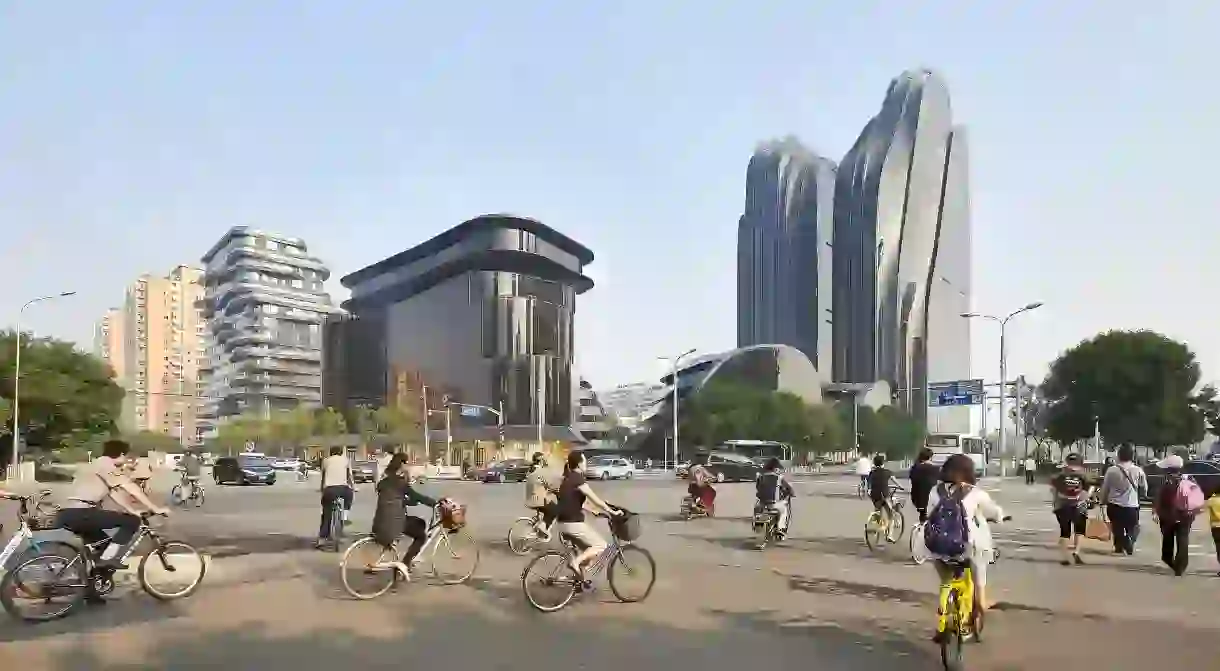A Guide to Chaoyang's Architectural Marvels

From the Bird’s Nest to the Big Pants, take a tour of Chaoyang’s most mesmerising pieces of modern architecture.
Covering a huge chunk of eastern Beijing, Chaoyang contains both Beijing’s Olympic Park and the Central Business District – but the glittering architecture doesn’t end there. Doughnut-shaped TV studios, a data centre resembling a microchip, towers designed to look like dancing Chinese fans… you won’t believe Chaoyang’s top ten architectural marvels.
CCTV Headquarters
Building, Architectural Landmark

To some, this gravity-defying skyscraper looks like a spaceship. To others, it looks like one of those never-ending MC Escher sketches. To Beijing locals, it looks like a giant pair of trousers – hence the nickname dà kùchǎ, or ‘big pants’. Unveiled before the 2008 Olympics in Beijing’s CBD area, the CCTV Headquarters form a three-dimensional loop of towers that appears to ignore the laws of physics.
China Zun
Architectural Landmark

Soaring above the streets below, the CCTV Headquarters’ vertiginous next-door neighbour is Beijing’s tallest building. The official name is CITIC Tower, but it’s universally known as China Zun, after an ancient Chinese wine vessel whose shape inspired the outward curve at the top of the structure.
Bird’s Nest
Stadium

This ultra-modern stadium was the shimmering centrepiece of the 2008 Olympic Games, which took place at the custom-built Olympic Green precinct in the northwest of Chaoyang. Officially called the Beijing National Stadium, the Bird’s Nest is another Chaoyang architectural marvel with a colourful nickname – this one inspired by the criss-crossed metal beams that comprise the arena’s facade.
Digital Beijing Building
Museum

Critics have slammed this imposing concrete construction as looking like something out of a dystopian George Orwell novel, but fans think it’s pretty clever; from the side it looks like a circuit board, while from the end, the four separate slabs resemble a barcode. Located in the Olympic Green, the Digital Beijing Building was built as a data centre for the Games, and is now a museum and exhibition space.
Phoenix International Media Centre
Architectural Landmark

Occupying the corner of Chaoyang Park, this doughnut-shaped masterpiece is one of Beijing’s most unusual architectural marvels. The sun-drenched offices of private broadcaster Phoenix Television are a warped web of twisted steel and 3,800 individual pieces of latticed glass, all bending around an open-air atrium in the centre.
Wangjing SOHO
Shopping Mall

Shopping malls aren’t always bastions of architectural innovation, but the Wangjing SOHO is a notable exception. Architect Zaha Hadid took her inspiration for this trio of curved asymmetrical towers from the traditional fans used in Chinese dance, but these silver-coloured metallic structures have also been described as interweaving mountains, giant pebbles and boat sails billowing in the breeze.
Beijing Yintai Centre
Architectural Landmark

From a distance, these three towers look like fairly ordinary skyscrapers, but take a closer look and you’ll spot the intricate design that crowns the main building, inspired by the wooden window latticework that’s so common in Chinese culture. A similar pattern covers the facade of all three towers, which contain exclusive offices, luxury hotels and five-star boutiques.
Water Cube
Stadium, Amusement Park

The Beijing National Aquatics Center – better known by its nickname, the Water Cube – was another unforgettable architectural highlight of the Olympics, with its glowing bubbles lighting up the Olympic Green. The arena is now home to the biggest indoor water park in Asia, if you feel like sliding into the water touched by the the world’s fastest swimmers during the 2008 Games.
Parkview Green
Shopping Mall

Taking up prime position on Chaoyang’s Dongdaqiao Lu thoroughfare, near the imperial-era Ritan Park, this sparkling glass structure contains a shopping mall, an art gallery, a boutique hotel and trendy office space. But Parkview Green is as impressive for its trailblazing sustainability features as it is for its gleaming facade – there’s a high-tech power-preserving airflow technique and cutting-edge water-saving systems; even the steel and glass shell has been designed to conserve energy.
Chaoyang Park Plaza
Architectural Landmark

This space-age skyscraper looms over Chaoyang Park like something that’s escaped from a sci-fi movie, until you realise it was inspired by traditional Chinese shanshui (literally ‘water mountain’) paintings. Chaoyang Park Plaza was designed as an extension of the garden landscape below, delivering a larger-than-life interpretation of the mountains and waterfalls depicted in those ancient ink masterpieces.













